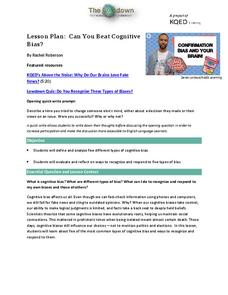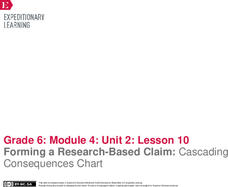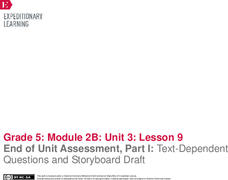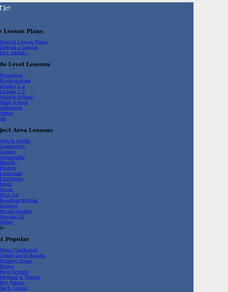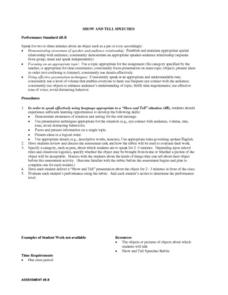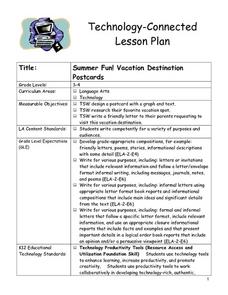EngageNY
Representing, Naming, and Evaluating Functions (Part 1)
Begin the discussion of domain and range using something familiar. Before introducing numbers, the lesson uses words to explore the idea of input and outputs and addresses the concept of a function along with domain and range.
Balanced Assessment
Mirror, Mirror II
Apply the concept of similar triangles to design a space in a room. Scholars use similar triangles to determine how a spotlight reflects from a mirror. After drawing the path of the spotlight, individuals find the smallest possible width...
NASA
Catch a Piece of the Sun
What does the sun mean to you? Learners have many different interests that may have connections to the sun. Whether its solar radiation, solar flares, or solar storms, there are connections to daily interests that may surprise your...
NASA
Developing an Investigation
Watch as your class makes the transition from pupils to researchers! A well-designed lesson has scholars pick a solar wind characteristic to research. They then collect and analyze official data from the LANL website. This is the third...
NPR
Can You Beat Cognitive Bias?
In a time of fake news, media manipulation, and Internet trolls, a resource equips learners with the tools they need to recognize and combat resources that are designed to appeal to our cognitive biases. Introduce learners to five...
Discovery Education
By the Foot: The History of Measurement
When is a foot not a foot? When you use the length of your own foot to measure distances, of course. To underscore the importance of standardized units of measurement, middle schoolers engage in a series of activities that ask them to...
EngageNY
Forming a Research-Based Claim: Cascading Consequences Chart
Is it relevant? Scholars choose a resource from their folders and search for relevant information about the harmful and beneficial consequences of DDT. They mark benefits in one color and harmful effects with another color. They then add...
EngageNY
End of Unit Assessment, Part 1: Text-Dependent Questions and Storyboard Draft: “You Can Do a Graphic Novel” Excerpt
Eyes on the finish line. Serving as the first part of the end of unit assessment, learners answer questions based on a text about how to write a graphic novel. Using what they've learned, they then create a storyboard about the invention...
Curated OER
Sonnets
Students examine the structure of sonnets. They compare and contrast them with modern day poetry. They write their own sonnet after changing the language in another sonnet to see why the author choosed certain words.
Curated OER
Designing the Careers Show
Students write a song. In this career lesson, students form groups based on occupational interests. Student groups write song lyrics about their chosen career. Students present their songs to the class.
Curated OER
Territorial Characters
Eleventh graders study the Kansas Territory. In this American History lesson, 11th graders read ten biographical cards and summarize the main ideas. Students create cards to play Who am I?
Pennsylvania Department of Education
6 Traits: Voice
Young scholars explore the trait of voice. In this language arts lesson, students focus on the writing trait of voice. Young scholars view a video and practice writing.
Pennsylvania Department of Education
6 Traits: Word Choice
Students explore language arts by participating in a vocabulary usage activity. In this word choice lesson, students read examples of great word usage in literature and discuss with the class why some words appear stronger than others....
Pennsylvania Department of Education
6 Traits: conventions
Students watch a video and write using conventions. In this conventions lesson plan, students edit their writing for the correct spelling, grammar, and paragraph usage.
Curated OER
Cell Pizza
Students identify parts and functions of microscope. Students watch video, Cells and Life about cell parts with actual pictures and actual cells. Students discuss video and identify parts of the cells that animals and plants have in...
Curated OER
Egyptian Mummification
Students explore Egyptian mummification and burial practices. They conduct research on gods, goddesses, afterlife, and mummification. Students dissect and mummify a frog "pharaoh and create a tomb wall for their frog "pharaoh."
Curated OER
An Encyclo-ME-dia for Every Child
Students create a digital scrapbook that shows information-text and pictures that are specific to each child. They make charts and graphs. They use digital cameras, scanners, software, to write captions, stories, poems, letters, and...
Curated OER
Living Longer
Students relate health information text to themselves and society. In this health information lesson, students answer questions using the 5 W's based on the health issue they are reading about. Students discuss life changes they might...
Curated OER
Show And Tell Speeches
Fourth graders choose a category to speak about for about two to three minutes. They deliver a show and tell presentation in front of the class. They complete a rubric on classmates for their accurateness of their presentation. They...
Curated OER
Imagining Your Science Fiction Short Story
Twelfth graders brainstorm ideas for their own science fiction story. Using worksheets, they sketch the plot and setting for their story. They create appropriate characters and develop their interactions among each other. They share...
Curated OER
Through the Years: Language Arts
Second graders read "The Hundred Penny Box" by Sharon Mathis Bell. They research each year of their life in preparation for writing an autobiography and develop notes to help them in later writing.
Curated OER
Rights and the Wyandotte Constitution
Students use graphic organizers to analyze the Wyandotte Constitution. They read and discuss the Wyandotte Constitution, identify the civil rights granted to the people of Kansas and consider exceptions based on gender and race.
Curated OER
Cows That Type Friendly Letters
Students engage in a lesson that introduces the parts of a letter. The lesson is taught using a powerpoint presentation with the purpose of integrating technology into instruction. Students create a letter and thinking map to challenge...
Curated OER
Summer Fun! Vacation Destination Postcards
Students design a postcard with a graph and text. They research their favorite vacation spot. Pupils write a friendly letter to their parents requesting to visit this vacation destination. Students use a Circle Map, to help fill in their...
Other popular searches
- Logical Order of Events
- Logical Order in Stories
- Pictures Logical Order
- Logical Order in Reading
- Sentences in Logical Order
- Paragraphs in Logical Order
- Chronological/ Logical Order
- Quiz Logical Order
- Language Arts Logical Order
- Quiz + Logical Order






